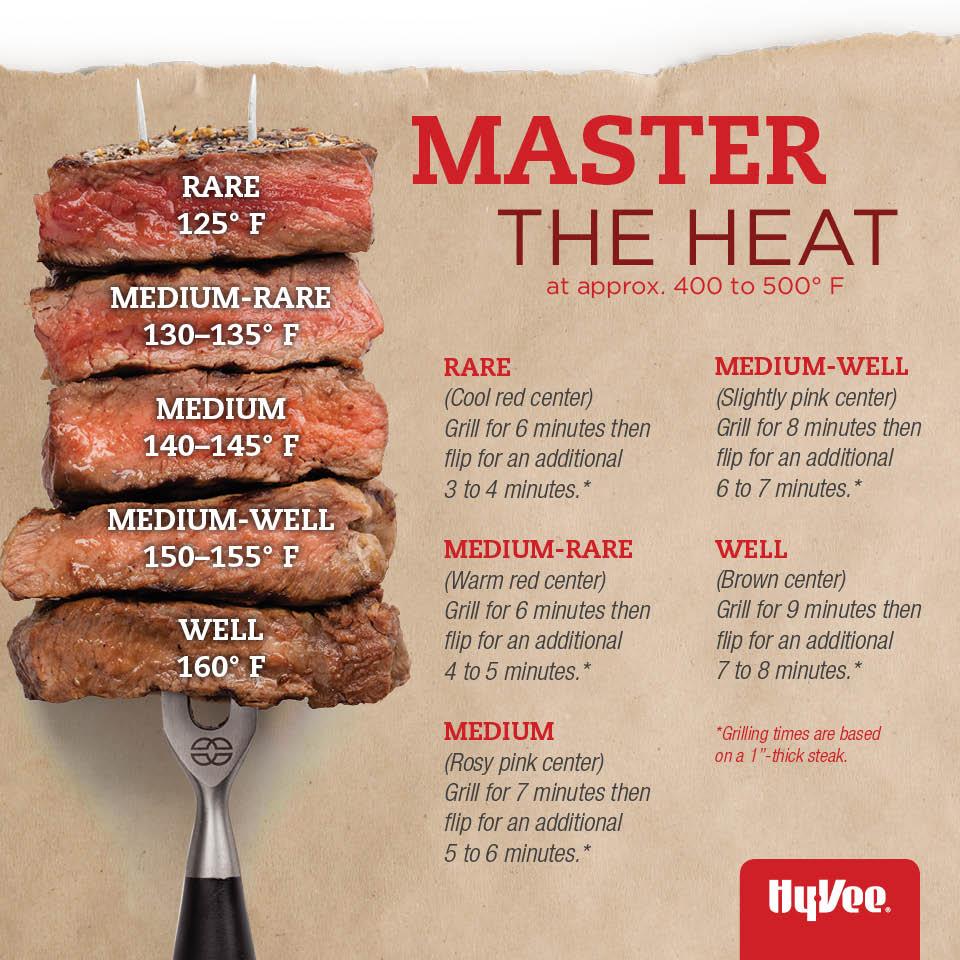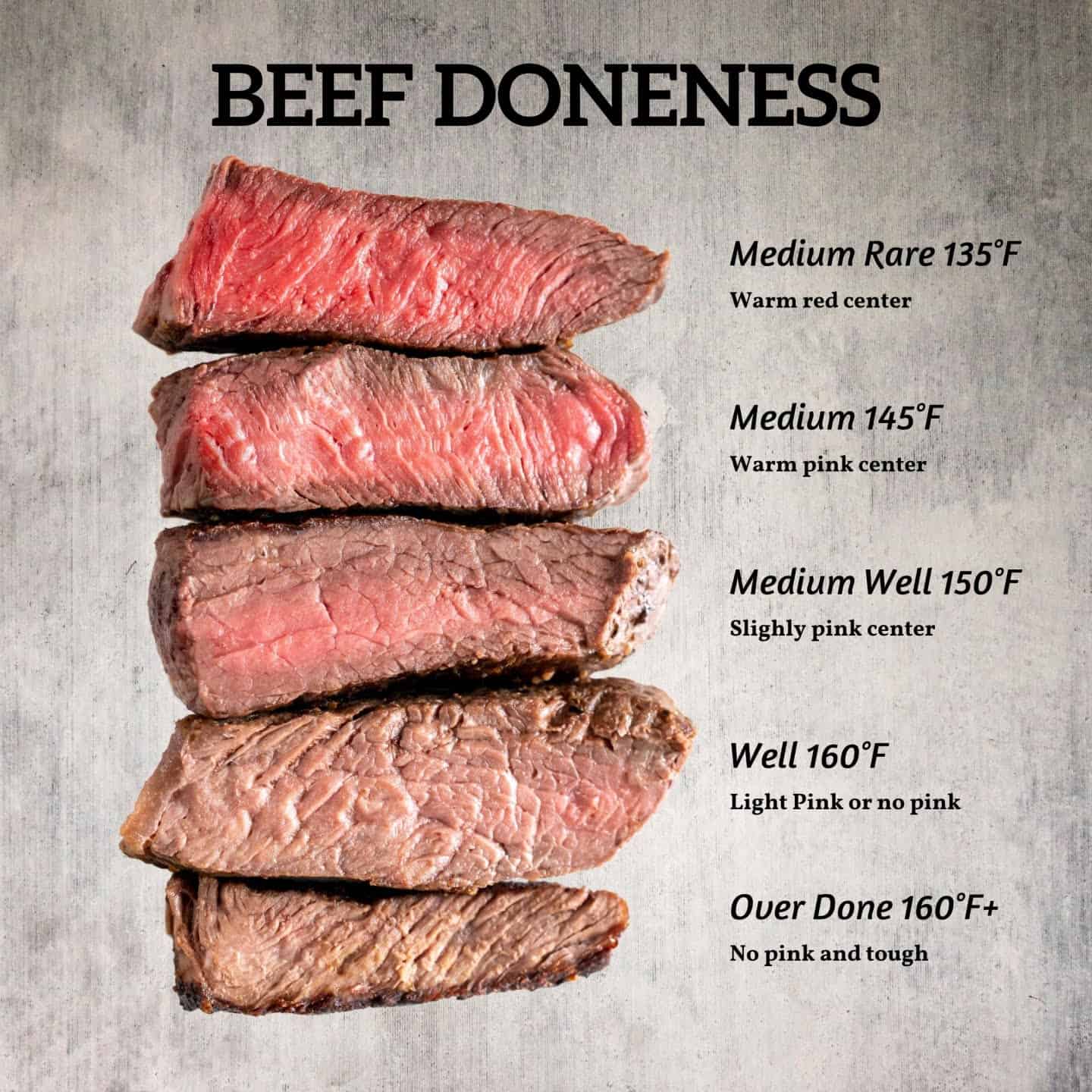Steak Doneness Guide: Temps, Tips, And Perfect Results!
Are you tired of serving steaks that are either shoe leather or practically mooing? Achieving perfectly cooked steak isn't a matter of luck it's a science, and mastering steak doneness through internal temperature is the key to unlocking culinary confidence.
The journey to grilling or pan-searing a steak to your exact preference might seem like navigating a minefield of uncertainty. However, with a grounded understanding of steak temperatures and essential tools, the process transforms from a daunting task into an achievable art form. This comprehensive guide is designed to illuminate the world of steak doneness, from the allure of rare to the steadfast nature of well-done, ensuring that every steak you prepare meets your exacting standards.
| Doneness | Internal Temperature (F) | Appearance | Texture | Notes |
|---|---|---|---|---|
| Rare | 120-130F | Bright red center | Cool, slightly chewy | Minimal sear on the outside. Remove the steak when it reaches 115F and let it rest for about 5 minutes. |
| Medium Rare | 130-140F | Warm, red center with dark pink edges | Tender, juicy | The most popular steak doneness. The fat melts, enhancing flavor and juiciness. |
| Medium | 140-150F | Warm, pink center | Firm, still juicy | A balance of tenderness and flavor. |
| Medium Well | 150-155F | Slightly pink center | Firmer | Some loss of juiciness. |
| Well Done | 160F and above | No pink | Dry, chewy | Ensure all harmful bacteria are killed off. |
To illustrate the power of precise temperature control, let's consider the career of Chef Antoine Dubois, a master of the art of grilling. For over three decades, Dubois has presided over some of the finest steakhouses in Paris, consistently delivering steaks cooked to absolute perfection. His secret? A relentless focus on internal temperatures and a deep understanding of how different cuts of meat respond to heat. Dubois's journey from a humble kitchen assistant to a Michelin-starred chef is a testament to the transformative power of mastering the fundamentals of cooking, especially when it comes to the art of the perfect steak.
- Entdecke Die Magie Die 5 Filmregeln Fr Cineasten
- Brisant Taylor Swift Matty Healy Amp Gabriella Brooks Das Drama Geht Weiter
| Category | Details |
|---|---|
| Full Name | Antoine Dubois |
| Date of Birth | March 12, 1968 |
| Place of Birth | Lyon, France |
| Nationality | French |
| Education | Le Cordon Bleu, Paris |
| Career | Executive Chef |
| Professional Experience |
|
| Awards & Recognition |
|
| Signature Dish | Cte de Boeuf, perfectly grilled to medium-rare |
| Website | example.com/antoinedubois (Note: This is a placeholder link.) |
USDA Guidelines
The quest for steak nirvana begins with the acquisition of a reliable meat thermometer. This tool, often overlooked, is the bedrock of precision cooking, allowing you to accurately monitor the internal temperature of your steak. Abandon the reliance on subjective guesswork or fleeting visual cues; a meat thermometer dissolves the uncertainty and empowers you to wield culinary control.
The medium-rare steak stands as a culinary icon, often considered the pinnacle of steak enjoyment. For this hallowed state, the internal temperature is paramount. The sweet spot lies between 130F and 140F. Within this range, the meat's proteins undergo a transformative coagulation, yielding a tender, flavorful steak while maintaining a delectable level of juiciness. Many discerning restaurantsly serve their steaks medium-rare unless otherwise specified, solidifying its reputation as the gold standard for steak aficionados.
- Filmy4wap Co Kostenlose Filme Risiko Oder Chance
- Entdecke Peter Santenello Reiseikone Erfolgsgeheimnisse Inspiration
When setting your sights on medium-rare perfection, it's crucial to remove the steak from the heat whether it be the grill or the pan when the internal temperature registers around 125F. The residual heat within the meat will continue the cooking process, causing the internal temperature to climb by a few degrees during the vital resting period. This resting phase, typically lasting several minutes, is non-negotiable. It allows the steak's precious juices to redistribute throughout the muscle fibers, culminating in a more tender and flavorful final product.
For a truly transcendent medium-rare experience, the final temperature of your steak should hover around 135F. While minor variations are permissible, this carefully calibrated range ensures the ideal equilibrium of tenderness and flavor. The result is a visual masterpiece: a warm, red center encircled by a halo of dark pink edges. The exterior will boast a captivating sear, a testament to the Maillard reaction, unlocking the meat's inherent savory qualities.
While internal temperature reigns supreme in determining doneness, it's essential to acknowledge the interplay of other influential factors, including the specific cut of steak, the chosen cooking method, and the steak's thickness. Different cuts, possessing unique muscle structures and fat content, may require adjusted cooking times to reach the same internal temperature. For instance, a thinner cut will inevitably cook at a faster rate than its thicker counterpart. Furthermore, the cooking method itself whether it be grilling, pan-searing, or broiling exerts a profound influence on the overall cooking process and the ultimate result.
While medium-rare enjoys widespread adoration, the ultimate steak experience remains a matter of personal preference. Some palates crave a more pronounced sear, while others gravitate towards the allure of a rarer, cooler center. Regardless of your individual leanings, the cornerstone of steak perfection lies in a thorough understanding of internal temperature and a keen awareness of how the cooking process shapes the final outcome.
When the moment arrives to unleash your inner grill master, aim for a surface temperature of 450F. For a rare steak, remove it from the heat when its internal temperature registers between 115F and 120F, typically requiring a grilling time of 3 to 4 minutes per side. This creates a vibrant red center.
A rare steak can be a safe and delectable choice, provided that its internal temperature reaches at least 120F. This achieves a bright red center enveloped by a subtle char on the exterior. For the discerning palate, a properly prepared rare steak from a reputable steakhouse can be a truly unforgettable experience.
The resting period is a step of utmost importance. Once your steak has reached its target temperature, promptly remove it from the heat source and allow it to rest for a minimum of 5 minutes. During this crucial interlude, the steak's juices will redistribute themselves, resulting in a more tender and flavorful eating experience. Keep in mind that the internal temperature will continue to climb a few degrees after the steak is removed from the heat.
The concept of carryover cooking is essential to grasp. Even after the steak has been removed from the grill or pan, the internal temperature will continue to rise due to the residual heat. This underscores the importance of removing the steak from the heat source before it reaches its final target temperature. The resting period allows the internal temperature to stabilize and the juices to redistribute, leading to a more tender and flavorful final product. For a medium-rare steak, aim to remove it from the heat when it reaches around 125F, allowing it to reach a final temperature of approximately 135F during the resting period.
Crafting a steak can be deceptively complex, with a multitude of factors at play, ranging from the selected cooking method to the thickness of the cut. Accurately determining when the steak has reached its optimal temperature can be a challenge, even for experienced chefs. Achieving the perfect medium-rare steak is a common culinary pursuit, representing a harmonious balance of flavor and tenderness.
Following recommended temperatures ensures the elimination of potentially harmful bacteria, making steaks safe for consumption. These guidelines are rooted in the USDA's rigorous standards and recommendations for safely savoring your steak, and are considered sacred knowledge for most steak lovers.
The steak's visual appearance serves as an additional indicator of doneness, and carefully observing the color of the meat is essential when assessing its readiness. A bright red center typically signifies a rare steak, while a warm, red center with more pronounced browning on the edges suggests a medium-rare doneness. As the steak progresses further through the cooking process, the center's color will gradually transition from pink to light pink, mirroring the increasing levels of doneness.
When utilizing a meat thermometer, it's crucial to insert it into the thickest part of the steak, avoiding contact with bone, gristle, or pockets of fat, as these can skew the temperature readings. Precise placement is paramount for obtaining an accurate representation of the steak's internal temperature.
Therefore, the next time you embark on the culinary adventure of cooking a steak, remember these key principles. Embrace the mastery of internal temperatures, rely on the accuracy of a meat thermometer, and never underestimate the vital role of the resting period. With consistent practice, you'll develop the ability to create flawlessly cooked steaks, leaving yourself and your guests utterly satisfied with every delicious bite.
To achieve a rare steak, remove it from the heat when it reaches an internal temperature of 115F and allow it to rest for approximately 5 minutes before serving.
- Lesley Stahl Enthllt Das Lebenswerk Einer Journalistenlegende
- Filme Streamen Leicht Gemacht Dein Ultimativer Guide Jenna Ortega

The Only Steak Temperature Chart You’ll Need Steak School

A handy guide to Steak temperature and doneness coolguides

Steak Temperature Chart For Sous Vide Stefan's Gourmet Blog atelier yuwa.ciao.jp